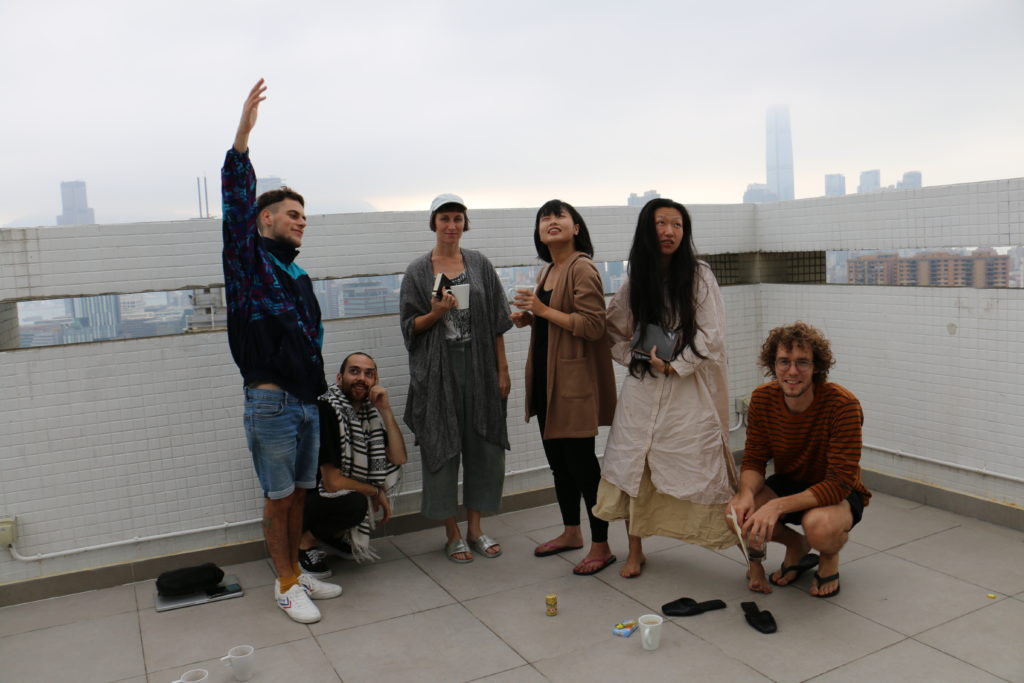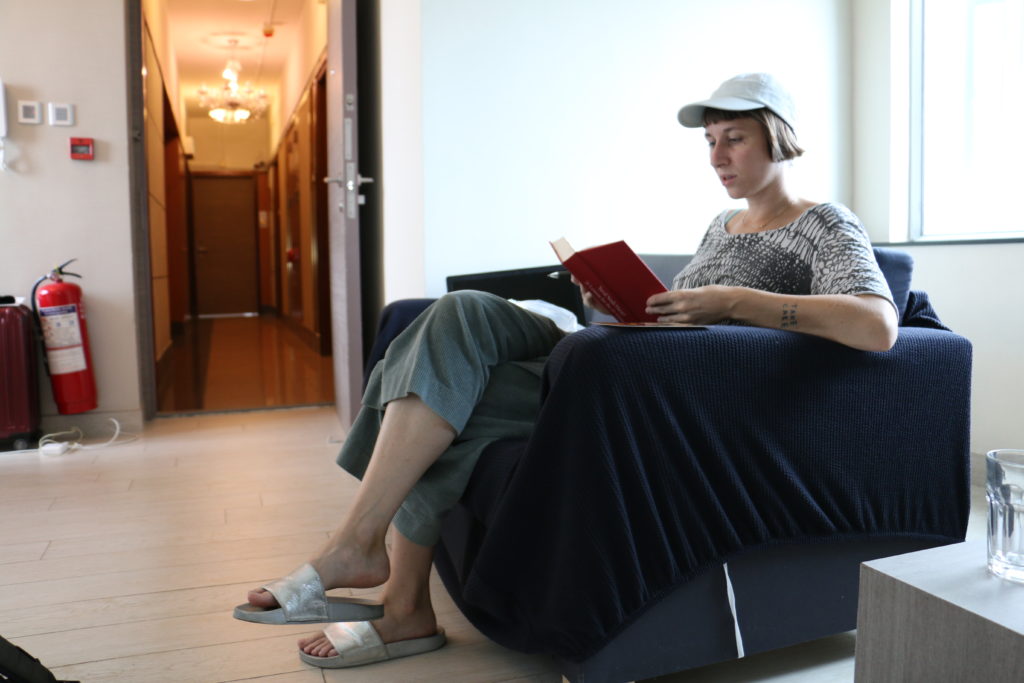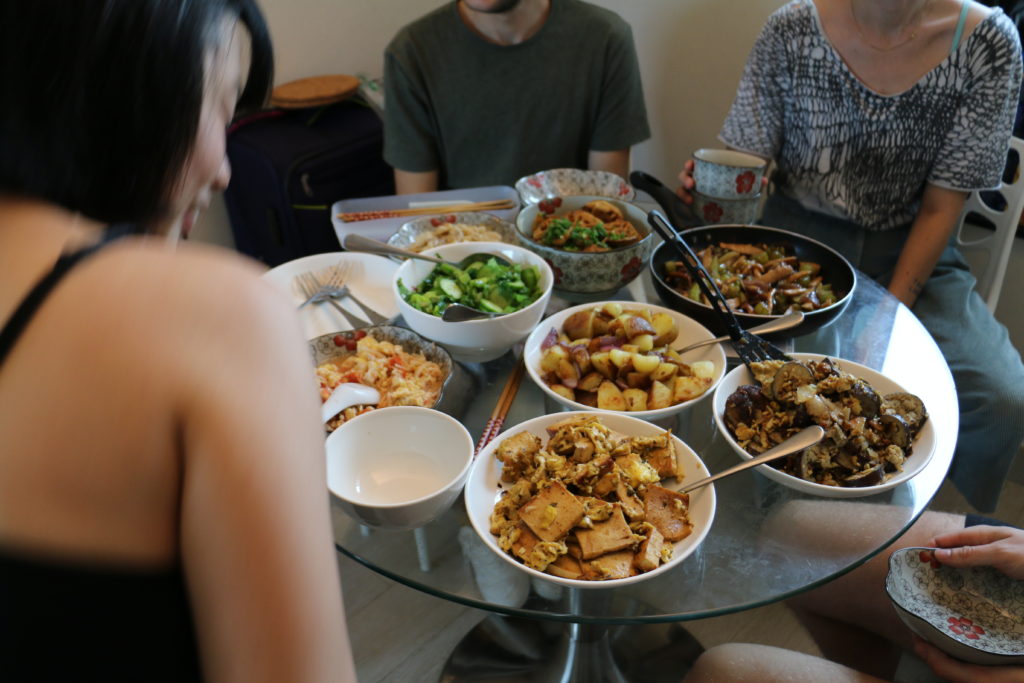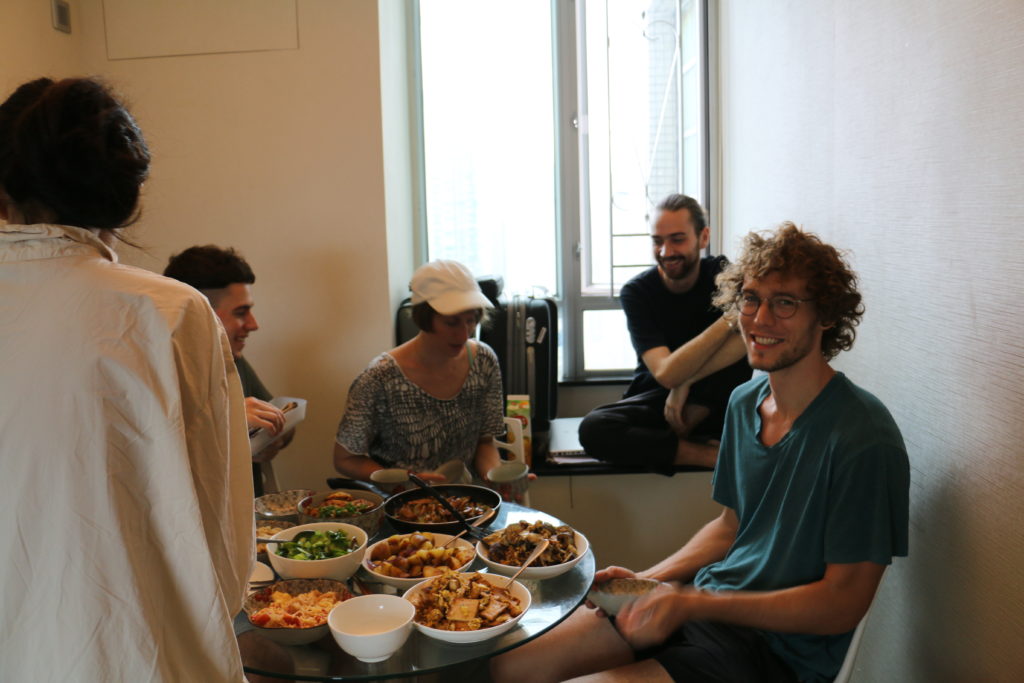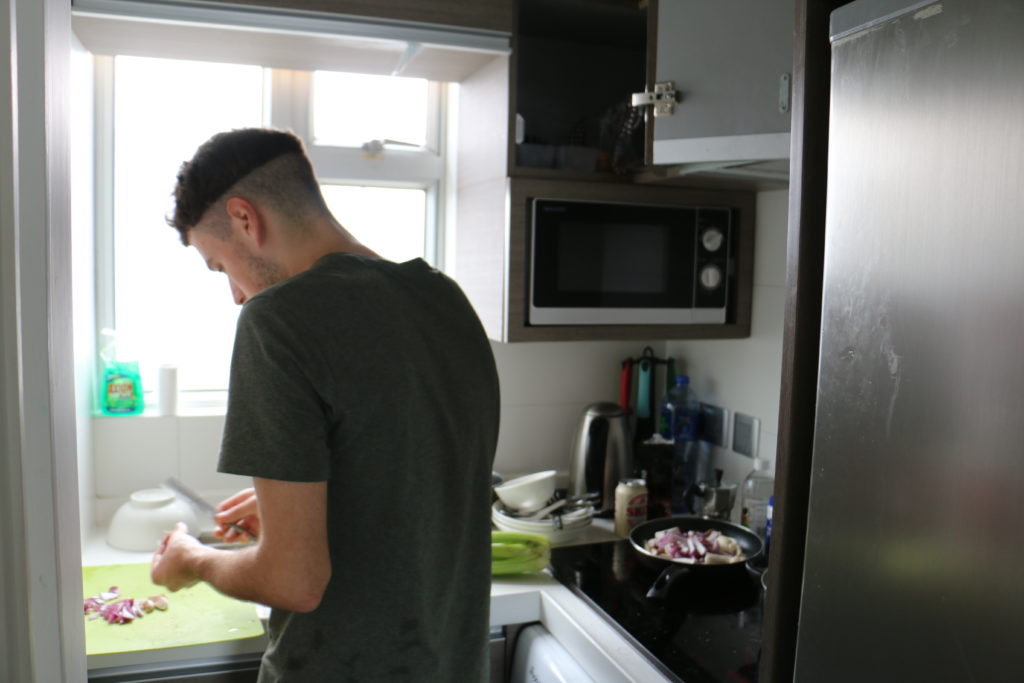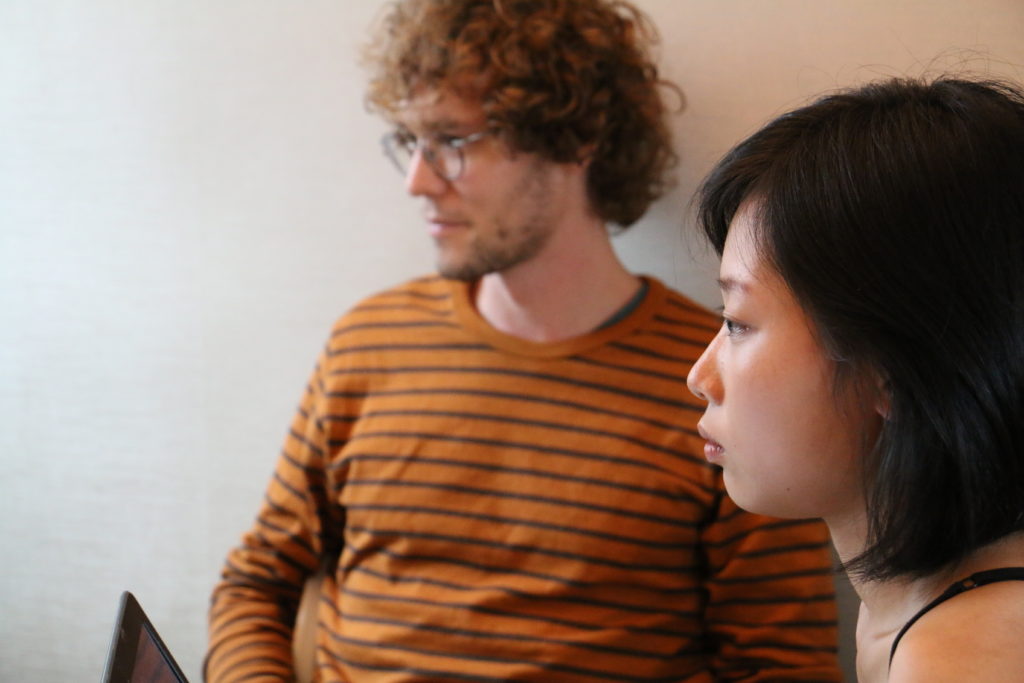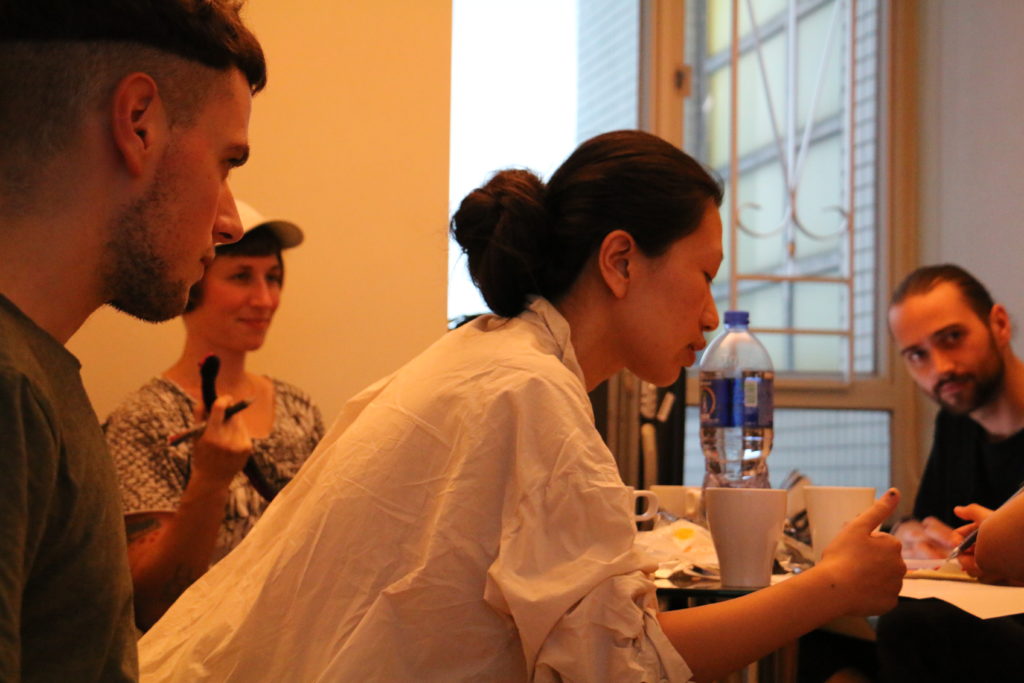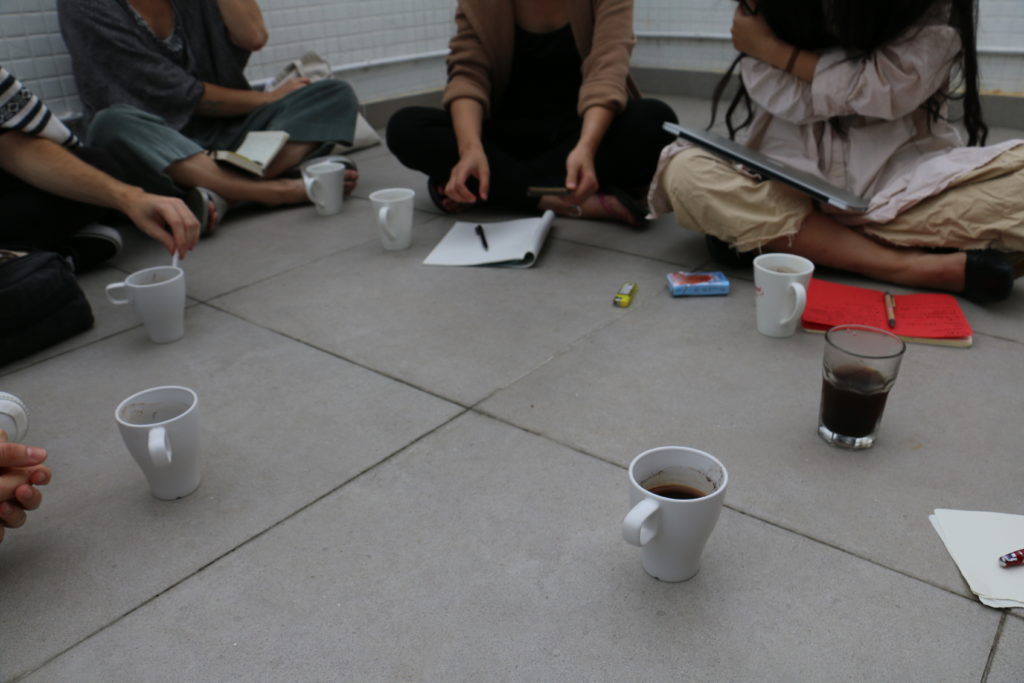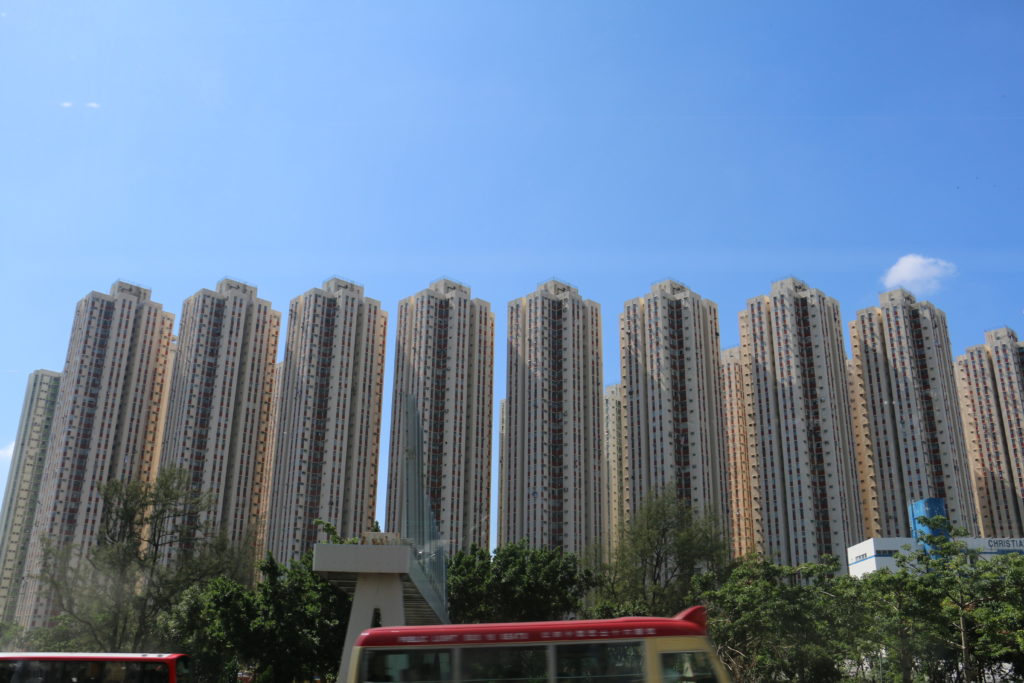For the third and last phase of this year’s programme, individual portraits of the current groups are published in order to give a glimpse into the day-to-day collaborations, convey the intensity of the work process and sketch the interplay between the individual and the collective. Today we present a day in the work of Keng Chen (fine arts/performance), Wen-Chi Liu (writing/fine arts/performance), Nikolai Prawdzic (dramaturgy/theatre), Dino Radoncic (design/performance), Nathalie Stirnimann (fine arts/performance) and Stefan Stojanovic (fine arts/performance) the result of which will be presented in the final group exhibition 说了/ 没说 : SPOKEN / UNSPOKEN on the 24th November 2018.
It’s a warm and cloudy day and as I get ready for my afternoon with another one of the programme’s collaboration teams, a message by Keng Chen appears on my screen: „Can you go to 32D? We meet there to eat together.“ Of course I can. As soon as the elevator doors opens with a cheeky dingdong on the 32nd floor of our high-rise home in the Hung Hom area, I hear Nathalie Stirnimann’s warm and gently rough voice. The door to the apartment is wide open and from the aisle I see Stirnimann’s crossed legs and a book on her lap. „The struggle of the working class… the job market… the technological revolution“, she’s reading Yuval Noah Hararis 21 Lessons for the 21st Century to Stefan Stojanovic who’s swiftly chopping potatoes in the kitchen. When noticed, I get hugs. Next door, I find Chen and Radoncic equally focused on frying tofu and assorted vegetables. These two only met three months ago, yet the natural way in which they interact suggests that they’ve been cooking together for much longer. Again, I get hugs. Two storeys down, Nikolai Prawdzic and Wen-Chi Liu prepare eggplants, mushrooms and lotus roots. Liu talks about an article on Taiwanese artists in Hong Kong that she’s currently working on while Prawdzic makes sure the scrambled egg doesn’t burn. And of course, here too I get hugs.
„You should see Stefan’s Serbian Christmas dinner. It’s just like this but 40 meters longer.“, I’m told as I stand marvelling at the buffet they’ve mounted. In Zurich, the performance duo Stirnimann/Stojanovic is experienced in collective action and decision-making—and in feeding many a hungry mouth at once. Their paths crossed 2015 in a performance project. Ever since they’ve become inseparable friends, lovers and mutual catalysts of creativity having developed dozens of performances and other projects together. Already for the first phase of TC, they teamed up with Chen, herself a seasoned performer, as well as Radoncic whom it might be fair to call an artistic hybrid having gone from design to community-based art up to intervention and performance. This match of four was bound to last and for the third phase is complemented by Prawdzic and Liu, the second of which they’d already worked with once. While Liu’s personal practice also lays an emphasis on performance (next to literature and cultural publishing), Prawdzic is more trained in working behind the scenes both in dramaturgy and directing roles for independent theatre productions and, in addition, has a past in sociology and hands-on political activism.
After lunch, the team decides unanimously on Turkish coffee on the roof where I get initiated into their plans for the final exhibition which I vow to keep secret until then. „We are interested in creating situations of insecurity where we are confronted with the unknown.“ Because they preferred to work in a public setting they took an interest a group of phenomenally bulky residential skyscrapers opposite Baptist University’s Kai Tak Campus. What if they did a roof performance with each of them on top a different building? Quickly they got infatuated with the idea and soon headed out to explore the premises. Rather by chance, they were able to slide into one of the buildings, pass the security personnel and ride up to the top floor. So far, no one had stopped them. But just when they opened the door to the roof, a mind-boggling alarm set in that took them by such surprise that they instinctively and without discussion turned around, rode the elevator down, paused on the 27th floor and considered what had just happened. A feeling of major insecurity—the thing they’d spent hours talking about—had caught them completely off guard.
They took this incident as inspiration for further discussion and started to think about how the mind reacts to a situation of danger, how it instantly starts calculating consequences and is torn between reason and instinct. They wrote to the skyscrapers’ administration in trying to go the official way but never got any reply. Then they started to imagine countless scenarios for the final exhibition. What if they accessed the roofs for their performance despite the alarm and without permission? What if they got scolded, fined or arrested? What if they got others into trouble by doing this? What if… Somehow, putting themselves in danger and challenging given security measures or the power relations attached to them with their own bodies became quite tempting. Besides they also wondered: does art enjoy some kind of jester’s licence that allows for crossing certain boundaries and if so, why? More and more, the simple (or not so simple) act of accessing the roofs turned into a metaphor for an act of danger necessary to free oneself from the restrictive, suffocating and oftentimes irrational protective measures in planned urban infrastructure and architecture. But if it was just a metaphor, did it actually matter if they really went up there or not? Shouldn’t they rather fictionalise the act and merge reality with illusion?
Their answers to these questions differed from one another and this point in the process is when I meet with them. Taking into account the individual sentiments about the delicate question of entering or not entering the roof for their final performance they figured that by inquiring into this very crossroad of their working process they could come to understand each other on a much deeper level. By not only asking who’d go up and who wouldn’t, they delved deep into the why of the issue, or rather of the feelings, fears and differing perceptions surfacing around it. Without rush and in order to learn about each group member’s attached doubts or inhibitions, they gave it some shared as well as individual time for reflection. This is why, after coffee on the roof we’re heading back down to the round table where the group embarks on an individual writing session considering the above questions. Not without everyone drinking a cup of water first: „You need to drink water, Keng.“ While they are silently typing away on their laptops, I reflect on all the tiny details that I’ve observed so far. That they show so much care for each other makes me think about the value of shared routines and rituals. They’ve obviously long recognised the importance of eating well, of looking after one another, of doing things one by one, of setting certain time slots for certain activities, of sometimes putting your phone into a box and of developing small tools to collaborate with more ease—not to say joy.
Such a tool is for example the hand game that they perform right after the writing session. It consists in reciting synchronically a Chinese phrase before pointing their arms into the center of the table—some palms facing up, some facing down. It’s an easy selection process to define who will be the next to give a statement. In an extensive subsequent discussion round I notice another essential skill of this extraordinary crew: they master the art of listening. Before discussing, every one is given the time, space and attention to express themselves. No reactions, only questions of understanding are uttered until all of them have shared their point of view. Whenever a language problem pops up, they take translation seriously and make time for it (they even keep a personal Jinglish dictionary: “What the fucks!”). If you’d stumble into room 32D on this mild afternoon without a clue of what’s going on, you’d never guess these people had to deliver a performance one week later. The way they talk is calm and considerate, as if they’d all the time in the world, yet focused. I find myself wondering whether this is the essence of process-oriented work—not having to rush anywhere while still pursuing an unknown destination.
Due to this process-orientation is the group’s tendency of going meta. Whatever appears is reflected, talked through and collectively examined. This is why the scale of the discussion is sweeping. It ranges from the felt sensations of an art piece to everything being an illusion anyway, from Žižek’s notion of humour to Fromm’s notion of suicide, from moral rules to criminal records, from integrity in art to criminality in tourism, from the legitimacy of fighting a system that’s not „yours“ to skyscrapers built exclusively out of stories, from performance rooted in real life to the value of juridical regulations, from safety zones to psychological doors that resemble the ones of Richland’s Garden, from the prison of the panopticum to questioning it all, from the innocence of just doing it to the dramatic scenarios of one’s own imagination, from law as a stranger to coexisting with the foreign, from the frames of art to feeling free on the first floor too, from simple bodies on a roof to belonging nowhere really, from the way to the result—and back to the way again. You wouldn’t believe it, but eventually out of all this an idea emerged. A sound and substantial idea concerning making big business with fashionable tails (I shall not say more). Oh, and also a second one concerning the final performance (I shall not say more). „Maybe it’s because of all the coffee and the chocolate but this is going really well.“, they say.

